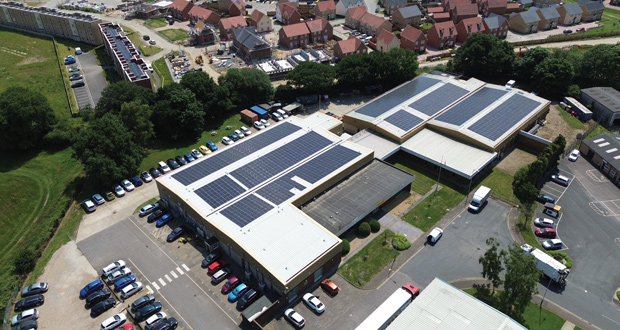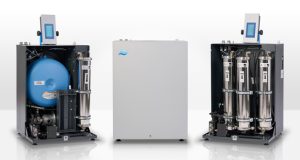Energy management has always sat squarely within the facilities manager’s remit, but in recent years it has taken on a new urgency. The UK has some of the highest industrial electricity prices in Europe, with prices 46% above the median of International Energy Agency member countries. Furthermore, costs are projected to remain high due to global market shifts and the electrification of heat and transportation, which will further increase electricity demand.
For businesses working on tight margins, these rising and unpredictable costs pose a serious risk – both financially and otherwise. Carbon emission targets are increasingly written into contracts and procurement frameworks, making environmental performance a commercial as well as regulatory concern. Meanwhile, power resilience is also creeping up the priority list.
In this context, renewable technologies like solar PV are rapidly becoming core tools for controlling costs, ensuring resilience and achieving a commercial advantage.
The financial benefit
Solar PV has the potential to save businesses thousands, if not millions. An installation of a 480kWp solar PV system at Fluke, a manufacturer and distributor of electronic tools and software, for example, will save the business more than £3 million as well as an annual saving of 380,000kWh of energy.
Ultimately, installing solar PV allows businesses to take greater control. By generating electricity onsite, facilities managers can reduce their business’s exposure to volatile market rates and policy-driven levies, with well-designed and funded systems delivering stable, low-cost electricity for20 to 25 years.
In sectors such as manufacturing and warehousing, where usage aligns well with daytime generation and roof space is readily available, solar PV can meet a substantial share of total demand, resulting in a payback period of between three and five years.
Resilience and reputation
While compelling, the financial case is not the only driver of solar PV investment. The National Grid has repeatedly warned of localised grid constraints, which will only heighten with electrification. In these cases, solar PV, particularly when paired with battery storage, can help protect operations by providing continuity of supply.
At the same time, environmental performance now plays a role in everything from securing procurement contracts to accessing finance. Scope 2 emissions reporting is becoming standard and companies are being asked to provide auditable progress on their carbon reduction strategies.
Owner vs tenant
For owner-occupiers, these drivers are often enough to make the business case stack up. However, in tenanted sites, the real challenge is making it commercially viable for the landlord too.
Fortunately, solar PV can appeal to the three key factors that most landlords consider: value, risk and compliance. A building with solar PV often benefits from improved EPC ratings and lower running costs, which strengthen its marketability. Likewise, it can help landlords stay ahead of tightening environmental performance standards, such as Minimum Energy Efficiency Standards (MEES) and net-zero reporting expectations.
Commercially, solar PV can also generate new revenue streams for the landlord, depending on how the deal is structured.
Structuring the deal
For tenants eager to make the case for solar PV to their landlords, several approaches are possible.
One route is to introduce a third-party funder via a Power Purchase Agreement (PPA). With a PPA, a third party owns and operates the solar PV system and the tenant agrees to purchase the electricity it generates at a fixed rate. This rate is typically below market cost and is agreed upon for a period of between 10 and 15 years, but can be up to 25 years, providing long-term stability in energy costs. With no upfront investment or maintenance responsibilities for either party, PPAs can offer immediate energy savings and long-term price certainty for tenants. For landlords, the key benefit lies in having a more attractive and energy-efficient property, often with improved EPC ratings and lower running costs, without capital outlay.
Alternatively, landlords can take a more active role by funding the system themselves, either directly as the PPA funder or through asset finance. In doing so, they become the energy provider to their tenants, charging a reduced but steady rate for the electricity and creating a new income stream. This model is especially appealing for landlords with long-term holdings or multiple tenants, as it enhances asset value while delivering a return on investment.
Some tenants have also negotiated hybrid agreements where both parties contribute to the cost of installation, with repayment mechanisms structured into adjusted rent or service charges. While these require more negotiation up front, they can create stronger landlord-tenant relationships and align both parties’ interests around long-term building performance.
Shared priorities, shared benefits
As these examples demonstrate, multiple routes are available, all of which can be mutually beneficial for both tenants and operators. The key is to ensure discussions start with commercially sound proposals that include funding routes, performance data and clearly modelled outcomes for all parties.
To help this process, it’s crucial to select a partner that understands the priorities of both tenants and landlords and works with all parties to structure proposals that don’t just make environmental sense, but business sense too.
To help facilities managers develop a business case for their sector, Geo Green Power has created a series of sector-specific guides. These will be made available online throughout the autumn at www.geogreenpower.com.
For more information visit www.geogreenpower.com or email info@geogreenpower.com or call 0800 988 3188.





